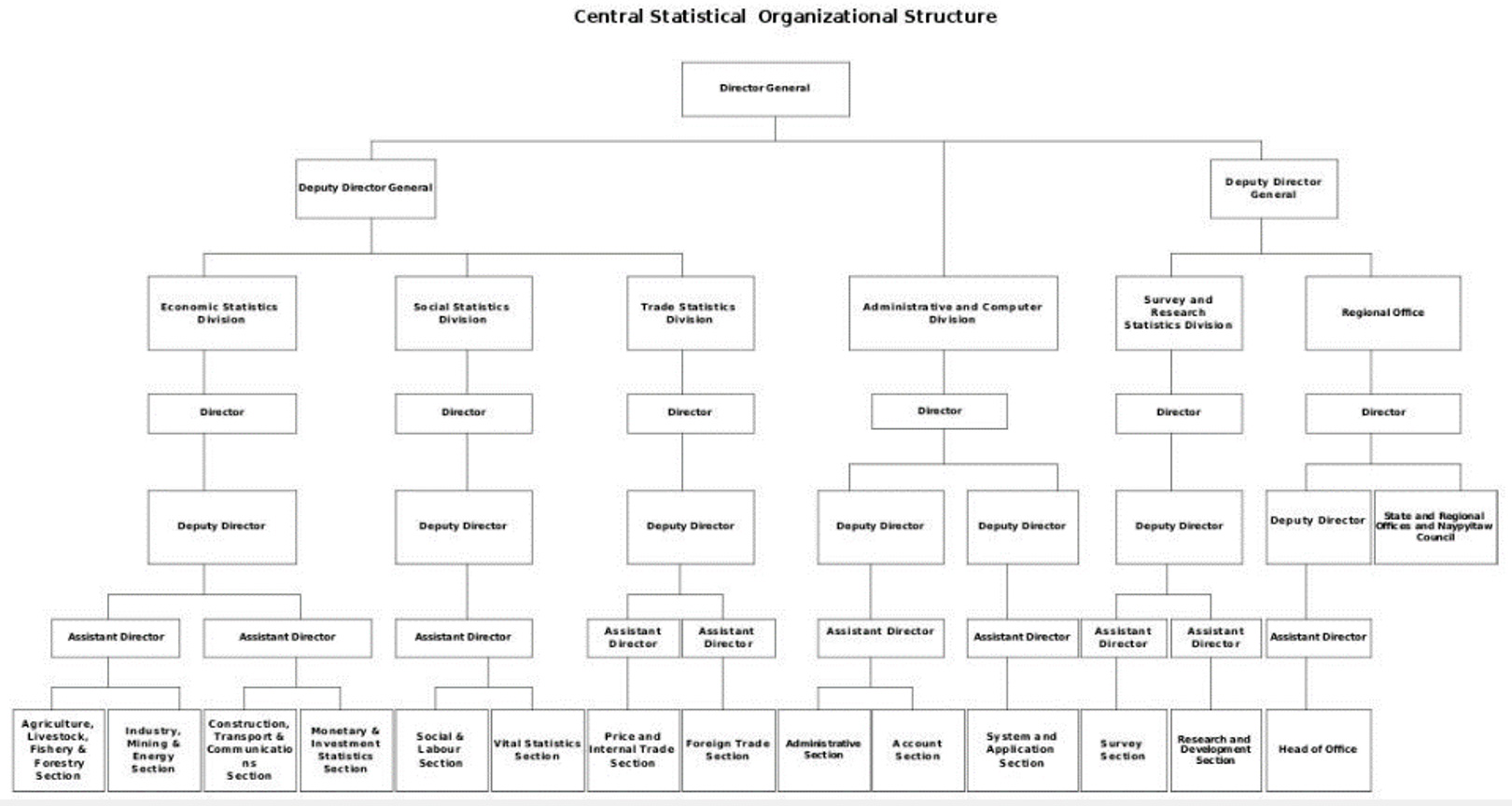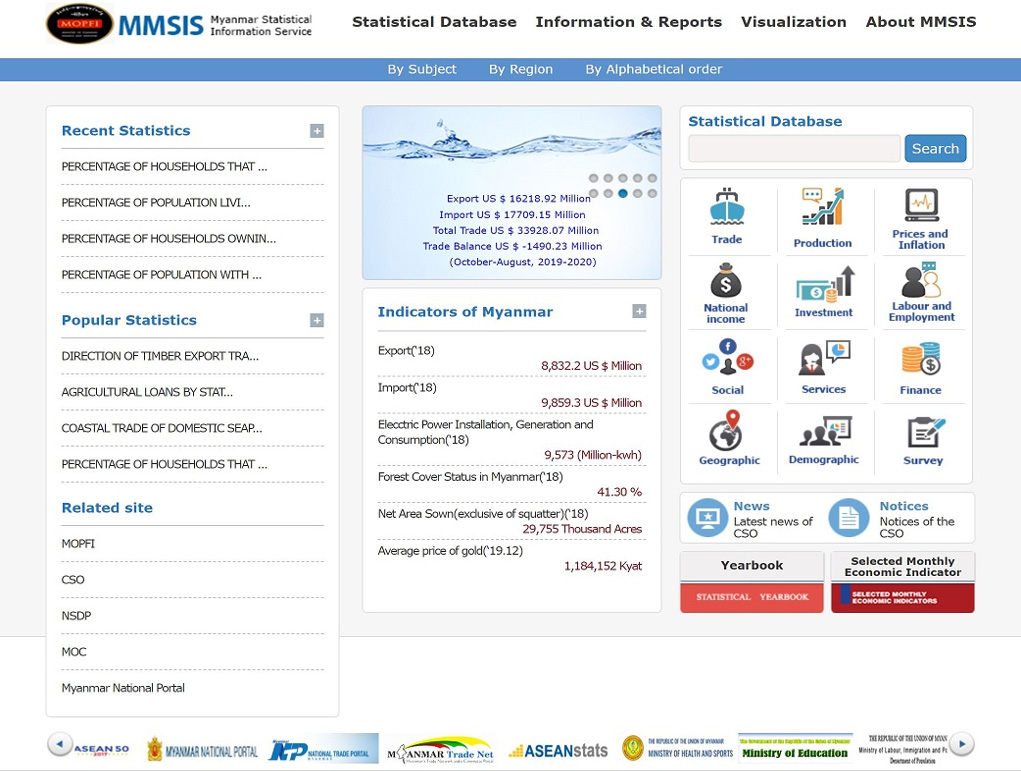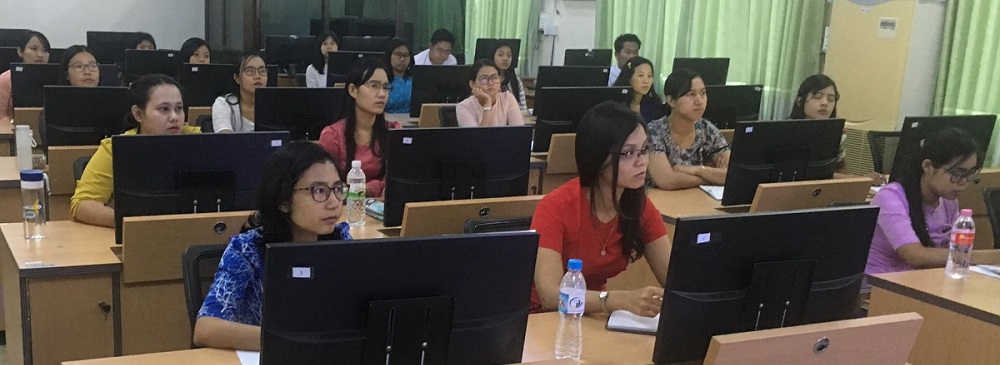Myanmar
I. General on SDG monitoring set up
National SDG organizational set up
Myanmar’s Statistics Law was approved by the national parliament and promulgated in 22nd January 2018, replacing the 66-year old Central Statistical Authority Act of 1952. The legislation designates the Central Statistical Organization (CSO) as the national statistical authority of Myanmar and is tasked to be the primary coordinator of statistical activities among the data-producing agencies/ministries of government in collection, compilation, maintenance and publication of statistical information. Administratively, CSO is under the Ministry of Planning, Finance and Industry (MOPFI).
The Law also mandated the formation of a high-level committee charged with the formulation of policies on all matters relating to government statistical operations, standards, classifications and coordination activities. The committee is led by the Vice President of the Union as Chairman; Union Minister of MOPFI as Vice-Chairman; the Director General of CSO as the secretary and Union Ministers from related statistical Ministries, the Region and State Governments; and two statistical experts as members.

The Myanmar Sustainable Development Plan (MSDP) supports the national development vision which mediates between local developmental needs and global sustainable development agenda. The MSDP is used to guide Myanmar’s achievement of the SDGs over the same timeline as of the global SDG agenda 2030. The CSO has been conducting National Indicator Framework (NIF) for monitoring and evaluation of MSDP. The CSO and UNDP jointly examined and discussed with line ministries and international organizations to define the indicators for the NIF. There are 286 indicators that have already been identified which will be used to monitor the situation in Myanmar in terms of sustainable development up to 2030. Among them, 72 percent of the indicators selected are readily measurable. The share of SDG indicators are 41 percent and national indicators are 59 percent, which meet the objective set in the NIF.
National set of SDG indicators
The MSDP is structured around 3 Pillars, 5 Goals, 28 Strategies and 251 Action Plans. It has been aligned with the SDGs, the 12 Point Economic Policy of the Union of Myanmar, and various regional commitments which Myanmar has made as part of the Greater Mekong Sub-region (GMS) Strategic Framework, the ASEAN Economic Community (AEC) and many others.
The CSO is the national focal point in producing SDG indicators data and produced the following publications: SDG Data Assessment Report: Readiness of Myanmar's Official Statistics for the Sustainable Development Goals (May, 2016); Hand book for SDG awareness; SDG Indicator Baseline Report: Measuring Myanmar’s Starting Point for the Sustainable Development Goals (August, 2017). The SDG data assessment report found that Global SDG indicators adoption is 196 out of the total 320 indicators or 61%. The lowest indicator availability is for goals 13 and 14 (30% and 37.5%, respectively) and highest for goal 8 with 85%.
SDG reports and Voluntary National Reviews
Generally, National Statistical Offices (NSOs) all over the world are taking the role of Monitoring and Evaluation (M&E) on the progress of SDGs. It is the responsibility of relevant ministries and agencies to ensure that their development plans are in line with the sustainable development concept by checking with the broad goals, targets and indicators of the SDGs. The MSDP was introduced in 2018 and based on Global SDGs, the twelve economics policy, AEC and regional commitments. The MSDP-NIF was conducted, monitored and evaluated in cooperation with the development assistance coordination unit Myanmar, UNDP and MDI. The working group conducted the action plan and timeline of MSDP indicator frameworks as outlined; constructing mapping, conducting workshops, meeting with task teams, consolidating reporting for formal review & approval, and finding metadata & target development. The set of criteria to be considered when choosing suitable indicators for MSDP included alignment with MSDP strategy, data availability, approval from relevant departments and degree of impacts. The proposed strategic and project level projects from all ministries were focused and targeted in line with the MSDP development Goals, Strategies and Action plans. The monitoring and evaluation (M&E) processes were done in order for fulfillments of the intended target for sustainable development of Myanmar and Global Agenda.
Apart from that, this would also facilitate Myanmar’s vision of involving the Voluntary National Review (VNR) process after 2021, obtaining necessary baseline and subsequent year values of NIF indicators. Until now, we could not review processes on SDGs Implementation in Myanmar. The views and opinions of all stakeholders, including both public and private sectors at the national, regional and local levels are crucial in developing the VNR process. Therefore, the views and opinions of all stakeholders at all stages of review processes, such as planning and assessing of MSDP and its contributions to SDGs need to be incorporated. In addition, the VNR process would help to create a sense of ownership from stakeholders over the country's development efforts and keep all parties updated on the implementation status of each of the SDGs. The VNR process will need further assistance from the statistical as well as from the donor community. The challenges Myanmar has faced centered on the limited resources available and availability of accurate and reliable disaggregated data.
https://www. mmsis.gov.mm linked to the csostat website https://www.csostat.gov.mm of the CSO. Currently there is an ongoing effort in establishing an SDG front end platform based on Open SDG open source platform.

The CSO has a well-established data platform, MMSIS which currently does not have a section on SDGs. The UNSD-DFID project will work with the CSO on the dissemination of SDG indicators and facilitate training of CSO staff on SDGs data modeling and Statistical Data and Metadata eXchange (SDMX). UNSD conducted training on data modeling and SDMX for SDGs in Myanmar from 22- 25 October 2019.
Currently there is an ongoing effort in establishing an SDG front end platform based on Open SDG open source platform. At the same time, to fill the gaps, CSO is making an effort to define a new set of Common Data Platform (CDP) for the NIF with the support of UNDP. The scope of the CDP project will be to support the development of a SDMX complaint common data platform and allow seamless exchange of data and metadata among CSO and line ministries and also international organizations and their member countries.
Overall coordination of National Statistical System
The Myanmar NSS is a highly decentralized statistical system, consisting of all departments, ministries and institutions in the government of Myanmar engaged in the production of official statistics, whether primary statistical data are compiled towards collections or administrative records, or other statistical information.
To support proper monitoring of the SDGs, CSO led the development of National Strategy for development of Statistics (NSDS) with assistance of the World Bank. There are two main objectives in Myanmar NSDS, to identify detailed assessments which have a coherent strategy for a country to improve its national statistical system and to formulate an implementation plan with budget provisions over a medium-term timeframe. The Myanmar NSDS process was divided into two parts: Part I. Core Strategies and Part II. Implementation Action Plan. The NSDS assessment focused on four key aspects: a) institutional and legal framework, b) national data production framework, c) role and function of the CSO as national statistical coordinator, and d) data dissemination and user relations.
The Implementation Action Plan of the NSDS is to strengthen the Myanmar National Statistical System as a whole, through the development of all statistical units from the line ministries. The implementation plan is still being formulated, focusing on a set of actions and activities that need to be implemented in the next five years and update the assessment that was made in Part I. The NSDS implementation action plan describes critical actions that will support proper monitoring of the SDGs. It includes a updated assessment of the current state of the NSS with a focus on systemic improvement in support of the NSS: institutional and legal framework, user and provider relation, statistical and ICT infrastructures, as well as human resource and improvement of subject matter programs and methodologies: an assessment of economic, demographic, social and environmental statistics and strengthening capacity for monitoring of Global and National Development Plan.
SDG data coordination committees
As of now, a committee has not been officially formed in Myanmar.
Responsibility for SDG indicator compilation
The Myanmar statistical system is decentralized, and statistical production activities are scattered across the ministries and agencies. The statistical data producers in the national statistical system shall use appropriate ways to release the official statistics. The CSO, as the statistical authorized organization, is responsible for compiling and reporting SDGs indicators in Myanmar. SDG indicators which are included in the NIF for monitoring and evaluation of the MSDP (which is linked below), highlights its national goals and relevant links to individual SDG targets. Over 100 government departments will submit and report to the CSO annually. The CSO will also fit trends to each indicator and provide basic commentary on its movements and indicator interpretations and will submit the indicators report not only to the Planning Department (PD) but also to the Central Committee for Data Accuracy and Quality of Statistics (CCDAQS).
Here are one of the links for MSDP: https://www.mmsis.gov.mm.
Although the Myanmar Statistical System has improved over time, there is still fragmentation and limited coordination. The Myanmar Statistics Law therefore required all statistics related government departments and government organizations perform as the core stakeholders for implementing the National Statistical System and provide the required statistical data from the administrative records for carrying out statistical processes to the Central Committee or the person assigned by the Central Committee. The NSDS states that the lack of data sharing in a decentralized system will result in a proliferation of duplicative efforts to measure the same social, environmental or economic phenomena. The requirement for effective data-sharing across the government is more salient now and the cross-sectoral NIF to monitor and evaluate the MSDP defines 286 indicators produced by over a 100 government departments and shared with the CSO. As a result, a data sharing arrangement including common data definitions and an effective data sharing mechanism across the government will be required.
CSO is the national focal point in producing SDG indicators data. The 17 goals of the SDGs cover a large variety of socio-economic and natural dimensions that could be measured either at micro level (e.g. health or education) or at macro level (e.g. inequality, climate or infrastructure). Hence, computation of SDG indicators requires data from many sources, some easily available and others less so. Broadly speaking, the different indicators can be calculated either from micro sources (such as surveys or the population census), or from administrative databases (such as those maintained by the different ministries).
Actual data sharing mechanisms
The CSO is updating the socio-economic indicators on its website on a monthly, quarterly, and yearly basis. As a matter of good practice, and with the ongoing global integration and increased reliance on the Internet and electronic data transmission, the socio-economic indicators encourage the online release of data by providing at least one publicly identified and accessible location where data are available to all interested parties.
The CSO publishes Selected Monthly Economic Indicator (SMEI), Statistical Yearbook, Quarterly Planning and Economic Development Journal, Quarterly Statistics Bulletin, Myanmar Agricultural Statistics, including survey reports and also Annual Natural Disaster Survey Report. Time Series Data are disseminating in an online data dissemination platform, namely the MMSIS Website. Macroeconomic and Financial Data are also disseminated in the National Summary Dissemination Page (NSDP) that is linked with MMSIS.
The MMSIS website is an open data platform and user-friendly application with versatile possibilities for presenting statistical tables with visualization features. The data set can be available in convenient and modifiable formats such as CSV, XLS, TXT file, and it can pass the metadata information. Moreover, MMSIS is also disseminating other statistical data by linking other webpages such as National Summary Dissemination Page (NSDP).
Under the UNSD-DFID project on SDG Monitoring, the workshop on capacity building on data modeling and SDMX for SDGs was undertaken with the objectives of mapping Myanmar's global SDG indicators to SDG Data Structure Definition (DSD) and converting them to the SDMX standard.
The Open Data Inventory (ODIN) is the only assessment of the coverage and openness of data on websites which are maintained by National Statistical Offices. In 2018, Myanmar received an overall score of 47 and ranking 78 in the world but 5 in the region. The ODIN categories consist of a score of 46 in social statistics, 61 in economic statistics, and 35 in environmental statistics.
IV. Data availability and disaggregation
Work to make more indicators available
The data shortage has emerged as a major challenge for monitoring SDGs. To address the data gaps, the stakeholders should take a coordinated approach, moving from a collection of individual programs to reduce duplication, increase efficiency and effectiveness. The statistical actors are finding ways to work together, adopting innovative technologies, and removing barriers to data sharing. For this to happen, capacity of CSO needs to be strengthened, the line ministries or departments should also take initiative in generating administrative data related to SDGs, and the development partners have to come forward immediately to strengthen CSO and other line ministries/departments capacity to increase the availability of high quality, timely and reliable data disaggregated by age, race, ethnicity, migratory status, disability, geography, etc. In monitoring SDG implementation, the CSO has to try to focus on disaggregated data.
Work to allow more disaggregation
Disaggregated data plays a vital role in monitoring and evaluating SDG implementation. For this purpose, the disaggregate data are mainly focused on identifying the indicators, using a coordinated approach. The disaggregated data of the NIF which are allowed include urban/rural, state/region, township, sex and age.
The availability of metadata describes a vital component of expanding the use of indicators. The CSO pays attention not only to indicators but also metadata. Generally, Myanmar follows the guidelines from Inter-agency and Expert Group on SDG Indicators (IAEG-SDGs) in identifying the SDGs indicators. To be performed in line with the guidelines, CSO organized a training to introduce the SDGs metadata during the processing of SDGs baseline report, with the support of UNDP.
UNSD conducted a metadata workshop from 5-7 February 2019. The three-day metadata workshop was attended by 54 participants representing 20 government departments from several government ministries, together with representatives from UNDP and UNFPA.
The workshop provided a venue for discussing SDG monitoring best practice, focusing on the use of standardized metadata, and made government functionaries and decision-makers aware of existing guides and tools for this purpose.
The CSO has met with PARIS21 to discuss a National Quality Assurance Framework (NQAF) but nothing has been put in place yet. Myanmar shared trust as the most important element for data sharing. The NSO has a Central Committee in place that discusses critical areas, such as data quality, data sharing amongst others, for not only SDG indicators but for other socio-economic indicators as well. However, Myanmar does not have a data sharing policy, and sharing data with various users remains a challenge.
In Myanmar, a very first draft User Engagement Strategy for the SDG indicators, or at least key elements of it, is expected to have been put together. This can then be used for further national interaction and adjustments. Key elements of a road map or implementation plan for how to reach the goals or targets of the strategy have been discussed and put tentatively together. The structure and set-up of these strategies depend on country preferences, both from the NSS and from users.
With the aim of increasing capacity in the national statistical system for formulating and implementation of a user engagement strategy, the visited mission to the departments, the workshop, training workshop and consultation meeting with the stakeholders, including the statistical departments, policy makers and data users with the support of UNSD were conducted. Emphasis is also placed on the media as a key user group; and it is recommended that workshops to build statistical capacity of the media are conducted as well as providing the media with brief, ready-for-publishing analysis on certain topics. As a result, the User Engagement Strategy (2019-2024) has been drafted.
Implementation plan and activities
The CSO, with support from UNDP, conducted SDG awareness seminars and campaigns in 2018 and it was recommended in the assessment mission report produced by UNSD that the development of a user engagement strategy needs to build on the experience and lessons learnt from these activities.
One of the strategic objectives of the NSDS calls for “The easy availability of statistical information to users at regional, national and international levels, with such information and data sets released according to internationally accepted periodicity and quality.” The strategy further calls for several actions to be taken in the area of user engagement including understating user requirement and having continuous interactions with users. Emphasis is placed on the media as a key user group; and it is recommended that workshops to build statistical capacity of the media are conducted as well as providing the media with brief, ready-for-publishing analysis on certain topics.
User engagement for statistics is not only relevant for the Statistics Law and NSDS, but also for the MSDP. The MSDP calls for “improving and legalizing citizens’ access to information and broaden the accessibility of information on statistics and other key information held by public authorities”. MSDP also calls for the development of a measurement and evaluation framework to measure progress in achieving the plan. It further calls for disseminating the information through multiple channels and engaging with the general public so that they are informed of the indicators that are used to track progress of the MSDP.
UNSD conducted a User Engagement Workshop in Myanmar from 26-30 August 2019. Building upon the Statistics Law, the NSDS and other relevant documents, a draft user engagement strategy was produced, which sets out the path towards continuous dialogue between users and producers of statistics to meet the goals and objectives of the various policy and strategic documents.


